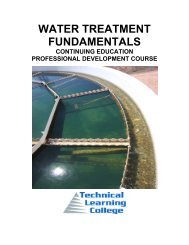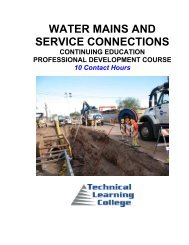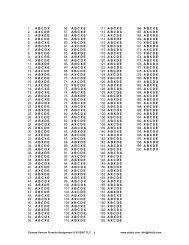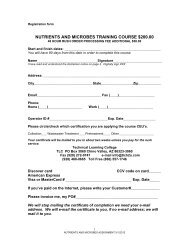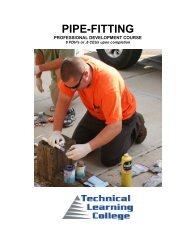Pump Primer 1 $100 - 8 Hours - Technical Learning College
Pump Primer 1 $100 - 8 Hours - Technical Learning College
Pump Primer 1 $100 - 8 Hours - Technical Learning College
You also want an ePaper? Increase the reach of your titles
YUMPU automatically turns print PDFs into web optimized ePapers that Google loves.
Dudley Castle Engine<br />
The first engine may have been erected in<br />
Cornwall in 1710, but the Dudley Castle<br />
engine of 1712 is much better known and<br />
thoroughly documented. The first pumps<br />
used in Cornwall were called bucket pumps,<br />
which we recognize as lift pumps, with the<br />
pistons somewhat miscalled buckets. They<br />
pumped on the up-stroke, when a clack in<br />
the bottom of the pipe opened and allowed<br />
water to enter beneath the piston. At the<br />
same time, the piston lifted the column of<br />
water above it, which could be of any<br />
length. The piston could only "suck" water<br />
33 ft, or 28 ft more practically, of course, but<br />
this occurred at the bottom of the shaft, so<br />
this was only a limit on the piston stroke. On<br />
the down stroke, a clack in the bucket<br />
opened, allowing it to sink through the water to the bottom, where it would be ready to make<br />
another lift. More satisfactory were the plunger pumps, also placed at the bottom of the shaft. A<br />
plunger displaced volume in a chamber, forcing the water in it through a check valve up the<br />
shaft, when it descended. When it rose, water entered the pump chamber through a clack, as in<br />
the bucket pump.<br />
Only the top of the plunger had to be packed; it was not necessary that it fit the cylinder<br />
accurately. In this case, the engine at the surface lifted the heavy pump rods on the up-stroke.<br />
When the atmospheric engine piston returned, the heavy timber pump rods did the actual<br />
pumping, borne down by their weight. A special application for pumps is to produce a vacuum<br />
by exhausting a container, called the receiver.<br />
Hawksbee's Dual Cylinder <strong>Pump</strong><br />
Hawksbee's dual cylinder pump, designed in the 18th century, is the final form of the air pump<br />
invented by Guericke by 1654. A good pump could probably reach about 5-10 mmHg, the limit<br />
set by the valves. The cooperation of the cylinders made the pump much easier to work when<br />
the pressure was low. In the diagram, piston A is descending, helped by the partial vacuum<br />
remaining below it, while piston B is rising, filling with the low-pressure air from the receiver.<br />
Bell-jar Receiver<br />
The bell-jar receiver, invented by Huygens, is shown; previously, a cumbersome globe was the<br />
usual receiver. Tate's air pump is a 19th century pump that would be used for simple vacuum<br />
demonstrations and for utility purposes in the lab. It has no valves on the low-pressure side, just<br />
exhaust valves V, V', so it could probably reach about 1 mmHg. It is operated by pushing and<br />
pulling the handle H. At the present day, motor-driven rotary-seal pumps sealed by running in oil<br />
are used for the same purpose. At the right is Sprengel's pump, with the valves replaced by<br />
drops of mercury.<br />
<strong>Pump</strong> <strong>Primer</strong> I Course © 12/1/2012 (866) 557-1746 www.ABCTLC.com<br />
32



